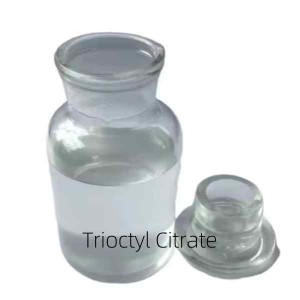Ethyl p-toluenesulfonate CAS 80-40-0
Product name:Ethyl p-toluenesulfonate
CAS:80-40-0
MF:C9H12O3S
MW:200.25
Density:1.174 g/ml
Melting point:29-33°C
Package:1 L/bottle, 25 L/drum, 200 L/drum
1.It can be used as ethylation reagent and photosensitive material intermediate, and also as toughener of cellulose acetate.
2.It is used to produce benzylammonium bromide in pharmaceutical industry.
3. Alkylating agent: commonly used to introduce ethyl groups into various organic compounds through nucleophilic substitution reactions.
4. Synthesis of sulfonates: It can be used to prepare sulfonates, which are useful intermediates in organic chemistry.
5. Precursor for other reactions: Ethyl p-toluenesulfonate can be used to synthesize drugs, agricultural chemicals and other fine chemicals.
6. Catalyst: In some cases, it may act as a catalyst for certain chemical reactions.
It is soluble in ethanol, ether, benzene, insoluble in water.

Stored at a dry, shady, ventilated place.
1. Temperature: Store in a cool and dry place away from heat and direct sunlight. Ideally, it should be kept at room temperature.
2. Container: Use airtight containers made of compatible materials (such as glass or certain plastics) to prevent contamination and evaporation.
3. Ventilation: Make sure the storage area is well ventilated to avoid vapor accumulation.
4. Separation: Keep away from incompatible substances such as strong oxidants and strong bases.
5. Label: Clearly label containers with the chemical name, hazard information, and receipt date.
6. Safety Precautions: Observe all relevant safety guidelines and regulations for handling and storing chemicals.
General advice
Consult a doctor. Show this safety technical manual to the doctor on site.
Inhale
If inhaled, move the patient to fresh air. If you stop breathing, give artificial respiration. Consult a doctor.
skin contact
Rinse with soap and plenty of water. Consult a doctor.
eye contact
Rinse thoroughly with plenty of water for at least 15 minutes and consult a doctor.
Ingestion
Never feed anything from the mouth to an unconscious person. Rinse your mouth with water. Consult a doctor.
1. Regulatory Compliance: Make sure you comply with local, national, and international regulations regarding the transportation of chemicals. This may include following guidelines set by organizations such as the U.S. Department of Transportation (DOT) or the International Air Transport Association (IATA).
2. Proper Labeling: Clearly label the shipping container with the chemical name, hazard symbol, and any relevant safety information. If applicable, use appropriate hazard labels, such as flammable or toxic symbols.
3. Packaging: Use appropriate packaging materials that are compatible with ethyl p-toluenesulfonate. The container should be leakproof and not easily breakable. A secondary seal may be required to prevent spillage.
4. Temperature Control: If necessary, ensure shipping conditions maintain a stable temperature to prevent degradation or unwanted reactions.
5. Documentation: This includes all necessary shipping documents such as Safety Data Sheet (SDS), Shipping Declaration and any required permits.
6. Training: Ensure that personnel involved in the transportation process are trained to handle hazardous materials and understand emergency procedures in the event of a spill or accident.
7. Emergency Response: Have an emergency plan in place in case of a leak or spill during transport. This includes having a spill kit and appropriate personal protective equipment (PPE) ready.
8. Avoid Incompatible Materials: Ensure that ethyl p-toluenesulfonate is not transported together with incompatible materials that may cause hazardous reactions.


Yes, ethyl p-toluenesulfonate is harmful. Here are some key points about its potential harms:
1. Toxicity: Ethyl p-toluenesulfonate may cause irritation to the skin, eyes, and respiratory tract. Long-term or repeated exposure may cause more serious harm to health.
2. Carcinogenicity: Although sulfonates are not classified as known human carcinogens, animal studies have shown that some sulfonates have potential carcinogenic effects. Therefore, caution is recommended.
3. Environmental impact: If leaked in large quantities, it may cause harm to aquatic life and the environment.
4. Safety Precautions: When handling ethyl p-toluenesulfonate, always use appropriate personal protective equipment (PPE) such as gloves, goggles, and respiratory protection if necessary. Always work in a well-ventilated area and follow safety guidelines.
5. Material Safety Data Sheet (MSDS): Always refer to the MSDS for specific information on hazards, handling, and emergency measures associated with ethyl p-toluenesulfonate.









